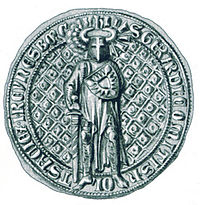Gerhard III. (Holstein-Rendsburg)
Gerhard III. (* around 1293; † April 1, 1340 in Randers ) from the Rendsburg line of the house of Schauenburg was one of the most important personalities of this family. This also resulted in his nickname " de groote Gert " (Gerhard the Great). In Danish historiography, however, he is known as Den kullede greve (the bald count).
Life
Gerhard III. was a son of Heinrich I and Heilwig von Bronckhorst . After the death of his father in 1304 he was Count of Holstein-Rendsburg , while his cousin Johann III. Holstein-Kiel ruled.
Gerhard thus owned the largest part of Holstein , while the other areas, which belonged to different cousins, were severely fragmented after several inheritance divisions. Johann and Gerhard tried to get this too. As Adolf VI. von Holstein-Pinneberg died in 1315, they tried to oust his underage son Adolf VII in order to increase their stake. However, the Duke Rudolf of Saxony as feudal lord of Holstein did not acknowledge their conquest. Adolf kept Holstein-Pinneberg in addition to the county of Schaumburg . Two other cousins, Christoph and Adolf, the sons of Johann II. Von Holstein-Segeberg , perished in 1313/15 by a lintel or by the hand of a nobleman who wanted to avenge his daughter's honor. When their father died in 1321, Gerhard and Johann shared his dominion.
In the following years Gerhard played an important role in the domestic politics of Denmark , which at that time was in a difficult domestic political situation. He had been able to bring much of the country under his influence when Erik VI. Menved mortgaged his property to pay for his wars. In 1326 Gerhard succeeded in getting his young nephew Waldemar III. of Denmark , the son of Duke Erich II. of Schleswig, instead of Christoph II. to install on the royal throne. From him he was enfeoffed on August 15, 1326 as the first Schauenburger with the Duchy of Schleswig . This was the first time that Schleswig and Holstein were in one hand. Waldemar had to assure that the duchy, which had been largely independent since 1241, would no longer have the same ruler as Denmark ( constitutio valdemariana ). Since Count Gerhard Waldemar was guardian, he could easily enforce this. When Waldemar lost the royal throne to Christoph again in 1330, he himself took over the ducal dignity of Schleswig.
Gerhard remained one of the most powerful personalities in Denmark and Schleswig. After the death of King Christoph in 1332, he took over the government of Jutland and Funen himself, while Johann kept the rest. Growing opposition and peasant uprisings led to anarchic conditions. The nobility that had previously supported him against Christoph II now demanded the throne for Christoph's son Waldemar . In 1340 Gerhard was slain by the Danish knight Niels Ebbesen . His sons waived claims in Denmark and followed him as Count of Holstein-Rendsburg.
The names of the great and the bald count show how differently Gerhard's historical achievement was assessed in German and Danish historiography. In the course of the national conflicts of the 19th century, Count Gerhard was highlighted on the Schleswig-Holstein side as the one who connected Schleswig with Holstein, which was regarded as an almost natural process. For the national Danish side, however, he was an occupier who further destabilized the kingdom in a time of crisis and seized part of the empire.
After Gerhard III. is the name of Gerhardstraße in Kiel.
Marriage and offspring
Gerhard III. was married to Sofie von Werle, the daughter of Nikolaus II. von Werle and had the following children with her:
- Heinrich II. (* Around 1317; † 1384 or later)
- Nikolaus (* around 1321; † 1397) ∞ Elisabeth von Braunschweig-Lüneburg, daughter of Wilhelm Duke of Braunschweig-Lüneburg
- Adolf (* around 1330)
- Elisabeth (* around 1340, † 1402) abbess in Elten
seal
(see illustration) Inscription: S (IGILLUM) * GERARDI * COMITIS * HOLTSACIE * I * REYNESBORCH (seal of Gerhard Graf von Holstein and Rendsburg)
literature
- Esben Albrectsen : Abelslægten og de habenburgske hertuger. In: Carsten Porskrog Rasmussen, Inge Adriansen, Lennart S. Madsen (eds.): De slesvigske hertuger (= Historisk Samfund for Sønderjylland. Skrifter. 92). Historisk Samfund for Sønderjylland, Aabenraa 2005, ISBN 87-7406-091-0 .
- Esben Albrectsen: The Abel family and the Schauenburger as dukes of Schleswig. Carsten Porskrog Rasmussen, Elke Imberger, Dieter Lohmeier , Ingwer Momsen (ed.): The princes of the country. Dukes and Counts of Schleswig, Holstein and Lauenburg. Wachholtz, Neumünster 2008, ISBN 978-3-529-02606-5 , pp. 52-71.
- The little encyclopedia. Volume 1: A - K. Encyclios-Verlag, Zurich 1949, p. 600.
- Karl Jansen: Gerhard III. (Count of Holstein) . In: Allgemeine Deutsche Biographie (ADB). Volume 8, Duncker & Humblot, Leipzig 1878, pp. 738-740.
- Wilhelm Koppe: Gerhard III .. In: New German Biography (NDB). Volume 6, Duncker & Humblot, Berlin 1964, ISBN 3-428-00187-7 , p. 266 f. ( Digitized version ).
Individual evidence
- ↑ Hans Gerhard Risch: The county of Holstein-Pinneberg from its beginnings up to the year 1640 . Hamburg 1986, pp. 67-70
| predecessor | Office | successor |
|---|---|---|
| Waldemar V. |
 Duke of Schleswig 1326-1329 |
Waldemar V. |
| Heinrich I. |
Count of Holstein-Rendsburg 1304–1340 |
Heinrich II. And Nicholas |
| personal data | |
|---|---|
| SURNAME | Gerhard III. |
| ALTERNATIVE NAMES | de groote device; Gerhard the Great |
| BRIEF DESCRIPTION | Danish politician |
| DATE OF BIRTH | around 1293 |
| DATE OF DEATH | April 1, 1340 |
| Place of death | Randers |
